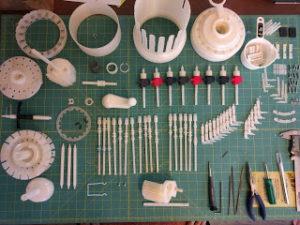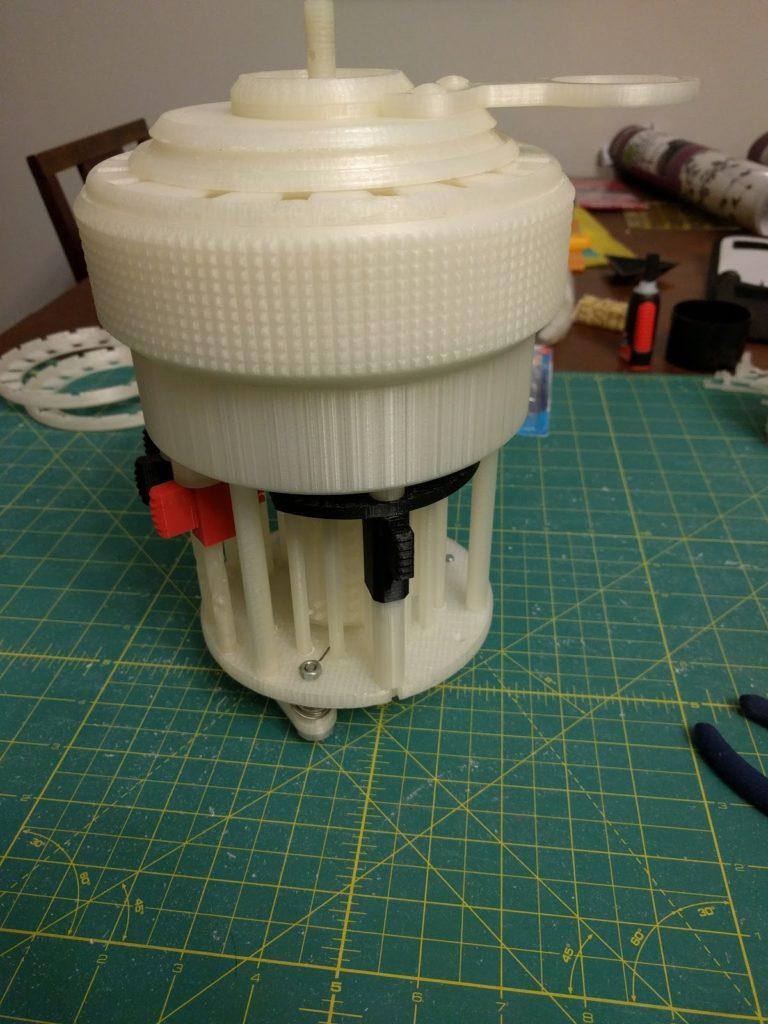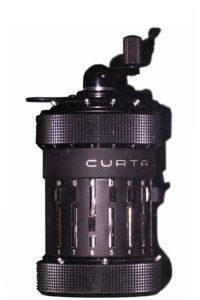Back in 1938, an Austrian engineer named Curt Herzstark patented his idea for the Curta, an elegantly mechanical pocket calculator that—to this day—has remained quite popular with collectors from around the world. Basically, the Curta works by inputting numbers using the slides on the side of the device, while the revolution counter and result counter are placed on top. Once the slides are set with the necessitated numbers, a single turn of the crank will add the inputted number to the result counter; if the crank is pulled upwards before being turned, then it will subtract the number from the total. Multiplication and division were also made possible through assorted crank and carriage modifications.
The Curta was widely considered to be the go-to calculator from the time it was first manufactured by the Liechtenstein-based company Contina AG Mauren in 1947, all the way to the 1970s, which was when the electronic calculator first broke onto the scene. Nowadays, the Curta is primarily seen as a visually appealing collectors’ item, and was recently recreated by a software developer named Marcus Wu, who used his newfound passion for 3D printing technology to produce the classic mechanical computing device. After he assisted his friend in assembling and calibrating a 3D printer, Wu became hooked on the possibilities of the emerging technology, and went on to build his own modified kit based off of the gCreate gMax 3D printer.
“I discovered the Curta Calculator shortly after finishing my printer build. I was collaborating with my younger brother on some prototypes of a product he was designing. We played a lot of disc golf and he wanted to build a mechanical 3d printed tool to track score,” Wu told 3DPrint.com. “While researching adding and counting mechanisms he discovered and shared with me the YouTube video, ‘How the CURTA Works’. From that point on I was fascinated with it. I started planning how I could build a simplified version of the calculator at first.”
 After Wu modeled the Curta parts in Onshape, he went on to run several tests in order to determine the best mechanical fit for all of the parts. The design and testing process took Wu about six months, and after he began printing the many parts of his Curta calculator design. According to the software developer, the originally styled Curta Type I calculator has more than 600 individual parts, while his version contains about 240 3D printed parts and 100 non-printed parts, which includes things like springs, ball bearings, nuts, and bolts.
After Wu modeled the Curta parts in Onshape, he went on to run several tests in order to determine the best mechanical fit for all of the parts. The design and testing process took Wu about six months, and after he began printing the many parts of his Curta calculator design. According to the software developer, the originally styled Curta Type I calculator has more than 600 individual parts, while his version contains about 240 3D printed parts and 100 non-printed parts, which includes things like springs, ball bearings, nuts, and bolts.
“I could have 3D printed the nuts and bolts and used a tap and die to thread them (in fact, I did do this for some non-standard screws such as the pin screw which holds the handle for the main crank to the crank), but a 100% 3D printed Curta wasn’t going to be possible due to the springs so I decided the extra work provided no real benefit,” Wu explained to us.
The Curta calculator design is extremely intricate, and each individual piece needs to be perfectly placed in order to ensure that the device functions properly. There were a number of inconsistencies and discrepancies that Wu was forced to overcome, but he managed to do this by comparing the Curta engineering drawings with his 3:1 scale prints and modifying his design. To give you an idea of the complexity of the Curta design, Wu explains that he has been hard at work on this project for well over a year now.
“I’ve been working on the project since the beginning of April 2015 and just recently finished getting it completely functional,” he told us. “A special thanks goes to my wife for being very patient with my project which has often produced annoying sounds (either the printer or the calculator itself) and has even helped me with it.”
 According to Wu, the assembled Curta weighs around three pounds, while experimentation and the numerous individual parts have already put him through two full spools of filament. Although he plans to make the source files available in the near future, he must first ensure that the files he releases are all accurate, and that he can successfully convey the instructions to make the complicated piece.
According to Wu, the assembled Curta weighs around three pounds, while experimentation and the numerous individual parts have already put him through two full spools of filament. Although he plans to make the source files available in the near future, he must first ensure that the files he releases are all accurate, and that he can successfully convey the instructions to make the complicated piece.
“I plan on releasing the source files to the public,” he told us, “but I need to ensure I release the corrected files and the files by themselves will not be of much use to most people — I also need to write up some tutorials for creating some tools that are necessary to build some of the parts (such as some custom springs needed) and some of my tools need revisions since there were manual alterations them after designing them.”
Additionally, he must also still paint and add numbers to the device he recently printed and assembled. All in all, Wu has done a marvelous job recreating a classic tool with an emerging technology. Those interested in learning more about Wu’s project can view his series of blog posts that detail his entire journey to design, print, and assemble his Curta calculator. He will also showcase the completed 3D printed Curta calculator—which even grabbed the attention of Adam Savage of Mythbusters fame—at the Charolette Mini Maker Faire, which takes place on October 8 at the Discovery Place. Discuss this topic further over in the 3D Printed Curta Calculator forum over at 3DPB.com.
Subscribe to Our Email Newsletter
Stay up-to-date on all the latest news from the 3D printing industry and receive information and offers from third party vendors.
Print Services
Upload your 3D Models and get them printed quickly and efficiently.
You May Also Like
3D Printing News Briefs, July 2, 2025: Copper Alloys, Defense Manufacturing, & More
We’re starting off with metals in today’s 3D Printing News Briefs, as Farsoon has unveiled a large-scale AM solution for copper alloys, and Meltio used its wire-laser metal solution to...
3DPOD 260: John Hart on VulcanForms, MIT, Desktop Metal and More
John Hart is a Professor at MIT; he´s also the director of the Laboratory for Manufacturing and Productivity as well as the director of the Center for Advanced Production Technologies....
3D Printing News Briefs, June 28, 2025: Defense Accelerator, Surgical Models, & More
In this weekend’s 3D Printing News Briefs, 3YOURMIND was selected to join an EU Defense Accelerator, and PTC has announced model-based definition (MBD) capabilities within Onshape. Finally, a study out...
EOS in India: AM’s Rising Star
EOS is doubling down on India. With a growing base of aerospace startups, new government policies, and a massive engineering workforce, India is quickly becoming one of the most important...


































